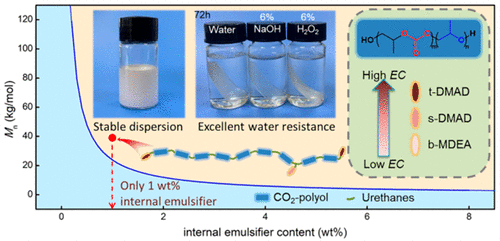当前位置:
X-MOL 学术
›
Macromolecules
›
论文详情
Our official English website, www.x-mol.net, welcomes your
feedback! (Note: you will need to create a separate account there.)
Terminal Hydrophilicity-Induced Dispersion of Cationic Waterborne Polyurethane from CO2-Based Polyol
Macromolecules ( IF 5.1 ) Pub Date : 2020-06-28 , DOI: 10.1021/acs.macromol.0c00606 Runan Gong 1, 2 , Han Cao 1, 2 , Hongming Zhang 1 , Lijun Qiao 1 , Fosong Wang 1, 2 , Xianhong Wang 1, 2
Macromolecules ( IF 5.1 ) Pub Date : 2020-06-28 , DOI: 10.1021/acs.macromol.0c00606 Runan Gong 1, 2 , Han Cao 1, 2 , Hongming Zhang 1 , Lijun Qiao 1 , Fosong Wang 1, 2 , Xianhong Wang 1, 2
Affiliation

|
Cationic waterborne polyurethane (CWPU) was initially developed as a specific adhesive for anionic surface but now is ubiquitous in innovative material systems such as poly(ionic liquid)s, polyelectrolytes, antibacterial coatings, and drug carriers. However, state-of-the-art CWPU faces imperative challenges like easy degradation and poor water resistance, which is caused by excessive incorporation of internal emulsifiers with tertiary amines into the backbone than necessary, since emulsification performance of cationic internal emulsifier is much less efficient compared with the anionic analogue. Here, a terminal internal emulsifier-induced efficient dispersion strategy was developed. Taking oligo(carbonate ether) diol (a CO2-polyol from telomerization of CO2 and propylene oxide) as example, stable CWPU with only 1.00 wt % internal emulsifier was prepared. An emulsifying capacity parameter was introduced to quantitatively evaluate the emulsification performance of internal emulsifier according to its steric hindrance and mobility, and the terminal internal emulsifier was proven to show the highest emulsification performance. The terminal hydrophilicity-induced dispersion strategy exhibits excellent universality for a broad range of oligomer diols, effective not only for CO2-polyols but also for widely used polyether polyols and polyester polyols, affording CWPU with excellent water resistance. Therefore, the chemistry disclosed here paves a way for a vast number of water- and oxidation-resistant CWPUs which were hardly available until now.
中文翻译:

基于CO 2的多元醇对末端水性的阳离子型水性聚氨酯分散体的影响
阳离子水性聚氨酯(CWPU)最初是作为用于阴离子表面的特殊粘合剂开发的,但现在在创新的材料系统(例如聚(离子液体),聚电解质,抗菌涂料和药物载体)中普遍存在。但是,由于阳离子型内部乳化剂的乳化效率低得多,因此,最先进的CWPU面临着诸如容易降解和耐水性差之类的紧迫挑战,这是由于内部乳化剂与叔胺过量掺入主链中所引起的,与阴离子类似物相比。在此,开发了一种末端内部乳化剂诱导的有效分散策略。从CO 2的端粒化反应中获得低聚(碳酸醚)二醇(一种CO 2-多元醇(例如环氧丙烷和环氧丙烷),制备仅具有1.00重量%内部乳化剂的稳定的CWPU。引入乳化能力参数,根据其空间位阻和迁移率定量评价内部乳化剂的乳化性能,并证明末端内部乳化剂表现出最高的乳化性能。末端亲水性引起的分散策略对多种低聚物二醇显示出优异的通用性,不仅对CO 2-多元醇有效,而且对广泛使用的聚醚多元醇和聚酯多元醇均有效,从而使CWPU具有优异的耐水性。因此,此处公开的化学方法为大量耐水和抗氧化的CWPU铺平了道路,而这些CWPU到目前为止都还不可用。
更新日期:2020-08-11
中文翻译:

基于CO 2的多元醇对末端水性的阳离子型水性聚氨酯分散体的影响
阳离子水性聚氨酯(CWPU)最初是作为用于阴离子表面的特殊粘合剂开发的,但现在在创新的材料系统(例如聚(离子液体),聚电解质,抗菌涂料和药物载体)中普遍存在。但是,由于阳离子型内部乳化剂的乳化效率低得多,因此,最先进的CWPU面临着诸如容易降解和耐水性差之类的紧迫挑战,这是由于内部乳化剂与叔胺过量掺入主链中所引起的,与阴离子类似物相比。在此,开发了一种末端内部乳化剂诱导的有效分散策略。从CO 2的端粒化反应中获得低聚(碳酸醚)二醇(一种CO 2-多元醇(例如环氧丙烷和环氧丙烷),制备仅具有1.00重量%内部乳化剂的稳定的CWPU。引入乳化能力参数,根据其空间位阻和迁移率定量评价内部乳化剂的乳化性能,并证明末端内部乳化剂表现出最高的乳化性能。末端亲水性引起的分散策略对多种低聚物二醇显示出优异的通用性,不仅对CO 2-多元醇有效,而且对广泛使用的聚醚多元醇和聚酯多元醇均有效,从而使CWPU具有优异的耐水性。因此,此处公开的化学方法为大量耐水和抗氧化的CWPU铺平了道路,而这些CWPU到目前为止都还不可用。











































 京公网安备 11010802027423号
京公网安备 11010802027423号